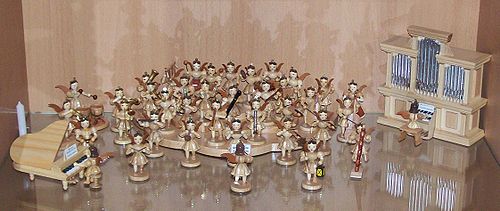Christmas angel
As Christmas angel small wooden figures are referred to the angels - usually an instrument playing - embody. They can be put together to form a whole orchestra . The origins of the artistic angel carving lie in the Ore Mountains , here the angels are an integral part of the Ore Mountains folk art .
The connection to Christmas results from the central role that angels play in the birth story of Jesus according to the Gospel of Luke : A single angel announces the birth of the Messiah to the shepherds, a whole choir of angels agrees on the Gloria in excelsis . In Christian tradition, angels are considered to be heralds of the Christian birth and bearers of divine light.
features
Christmas angels are always given wings to emphasize their heavenly character. They can be painted in natural wood or colored. With the colored angels, the color and decoration of the wings indicate the respective manufacturer, who cultivates this characteristic as a kind of trademark. The 3 best-known manufacturers are Wendt & Kühn , Blank from Grünhainichen and Uhlig from Seiffen.
Most angels stand on a small wooden pedestal, but there are also seated and hanging versions. The collector uses so-called clouds as platforms for the orchestra.
There are Christmas angels with most of the classical (without electrical sound generation) musical instruments in use in Europe , including grand piano and organ . Specialists carry candles, light a lantern or simply hold a music book.
history

In addition to the miner's figure, which has been central to the art of carving in the Ore Mountains since the end of the 18th century , the angel was widely used as a light carrier. The angel figures of the Erzgebirge folk art are characterized by great representations in small format. The first carved angels can be found by Veit Stoss at the end of the 15th century.
In order to meet the increased demand for Christmas angels due to the spread of Christmas customs, Seiffner wood turner developed the turned angel figure from the Nuremberg Kronendocke (rattle doll for toddlers) and the Rauschgoldengel around 1830 . This figure held lights in both hands, had wings on its shoulders, and had a gold crown.
In the early 20th century, some toy makers started making Christmas angels. The pioneers are Margarete Wendt , Margarete Kühn , Olly Wendt, b. Sommer and Georg Beyer, the inventor of the "Pleated Skirt Angel". Their creations enjoyed great popularity right from the start, but the spread of the Christmas angels beyond the Ore Mountains also determined the political framework. During the Second World War, production almost came to a standstill. In the GDR, on the other hand, the angels became an export hit and a source of foreign currency, which should only remain as unknown as possible in their homeland. Instead, the term “ year-end wing figure ” made the rounds.
After 1990 many of the Erzgebirge wood manufacturers made the leap into the market economy. Christmas angels continue to be an important element of the Erzgebirge folk art and are widely offered at Christmas markets. The variety of models produced has increased dramatically. Thus a new field of activity developed for many a collector for the Christmas season.
See also
literature
- Regina Krippner: The Museum for Mining Folk Art Schneeberg. On the story of carved angels. Retrieved July 12, 2016 (PDF, 361 kB).
Web links
- Simply heavenly! 100 years of Wendt & Kühn. MDR Saxony. The east - discover where you live . 2014, accessed January 4, 2016 .
Individual evidence
- ↑ a b c Regina Krippner: The Museum for Mining Folk Art Schneeberg. P. 4. Retrieved on July 12, 2016 (PDF, 361 kB).

